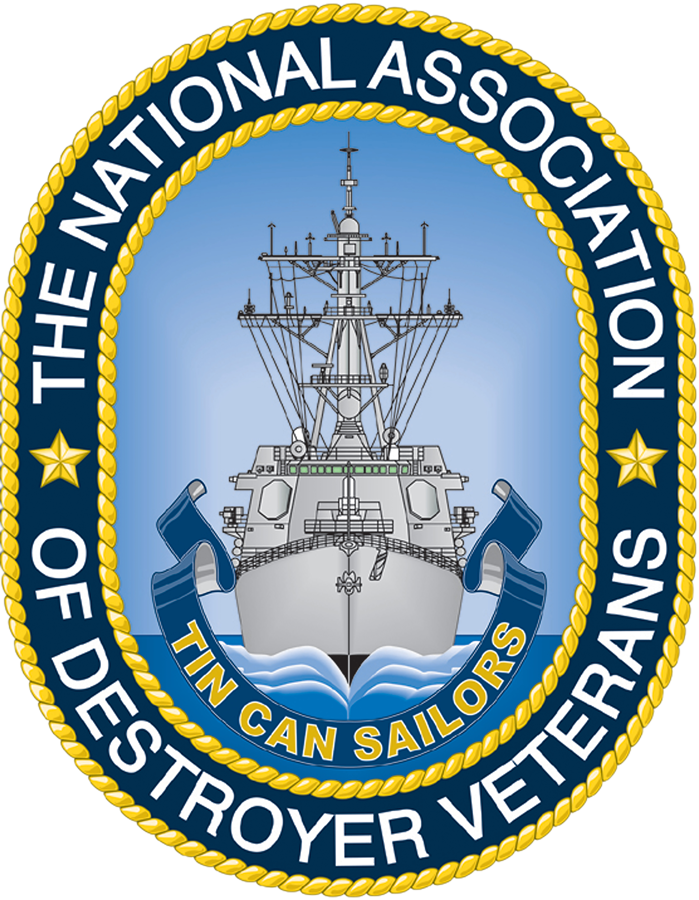A Tin Can Sailors Destroyer History
USS HENRY A. WILEY DD-749
The Tin Can Sailors, April 1999
The HENRY A. WILEY (DM-29) was named for a World War I battleship commander who went on to serve as Commander-in-Chief of the U.S. Fleet. At the time of his retirement in 1943, Admiral Wiley was head of the Navy Board of Production Awards. Launched on 21 April 1944, the former DD-749 was reclassified DM-29 on 20 July and was commissioned 31 August 1944.
After her shakedown in the Caribbean, the new minelayer sailed on 8 November for the Pacific where she earned her nickname “Hammering Hank.” A unit of Mine Division 8, the WILEY’s duty in the war zone began with the Gun Fire and Covering Force off Iwo Jima on 16 February 1945, three days before the first landing.
One account of the action off Iwo, beginning at 2145 on 20 February, is in the ship’s postwar cruise book. The marines ashore had called in fire support against the northeast side of Mount Suribachi. The WILEY closed to 500 yards of the beach — some of her crew, who believe she scraped bottom, will swear she was in closer — and the searchlight crew manned their stations. As the light’s beam lit up the “sheer, cave-pocked face of Suribachi” the guns opened fire. There’s “the stutter of the 50s, the bop-bop-bop of the 20s, the hard, sharp crack of the 40s, and the thunder of the six 5-inchers.” When the firing stopped a message came through from the Fifth Marines, “Well done. We owe you a cigar on that one.” The Hammering Hank remained there until 9 March, providing fire support and screening ships. The minelayer poured some 3,600 rounds into the rocky Japanese fortress.
Okinawa presented an even more difficult campaign as the WILEY steamed into position 23 March, eight days before the landing. Her first duty was screening minesweepers as they cleared the channels for transports and support ships. Japanese resistance was fierce and air attacks were almost unceasing. The worst two-day period began at 0615 on 28 March when the gun crews took a Val under fire and splashed it two minutes later. A minute later they were firing at a second and at 0622 a third, which they splashed at 0623. The ship resumed its sweeping operations and shore bombardment. At 0034, she was on patrol when a second attack came. Within two minutes, she’d splashed another enemy plane and between rounds of harassing fire took two other planes under fire. At 0401 a Jake passed over the fantail and dropped a 500-pound bomb that exploded harmlessly 50 yards astern. At dawn, the WILEY’s guns brought down two Nates, and then her crew rescued a downed F4F fighter pilot from the escort carrier SARGENT BAY (CVE-83). On 1 April, the day that the U.S. put troops ashore, the WILEY destroyed her fifth kamikaze.
Tried in battle, the WILEY’s crew shifted their attention to radar picket duty and spent thirty-four days alerting the invasion forces to enemy air attacks. During that time, they took sixty-four enemy aircraft under fire and destroyed several. The morning of 4 May was especially eventful. It began at 0307 when the minelayer’s main battery gunners splashed a Betty. Then, at 0850, speeding to the aid of the LUCE (DD-522) that had been hit by a suicide plane and was sinking, the WILEY came under heavy air attack. In less than one quarter hour of heavy fighting, her gunners brought down three kamikazes and two human-piloted baka bombs. One of the latter was closing from the starboard quarter when it was hit. The bomb struck the water, bounced over the WILEY’s fantail, and exploded just off the port quarter. As a result of this action, the WILEY was the first ship in the Okinawa area to knock a baka bomb from the air and the first in the fleet to be credited with two such downings. The minelayer’s gun crews had expended 5,000 rounds of 5-inch and AA ammunition by the time they arrived in the area where the LUCE had sunk two hours earlier. The doomed destroyer sank at 0740 with 126 of her crew. Eleven men were picked up by the WILEY’s crew. LCI-118, which came along side transferred thirty more for medical attention. By noon, all of the survivors were aboard KILTIE (APD-15) and on their way to a hospital ship.
The WILEY was patrolling north of Kerama Retto on 5 May when lookouts sighted a Japanese pilot swimming in the water. As the DM approached, however, he removed his life jacket and disappeared. The crew searched for his body, but without success.
On 12 June, the WILEY left Okinawa for the East China Sea to screen minesweepers at work there. She was on duty there when peace came. Even that was ushered in to the sound of Hammering Hank’s guns. During the night of 14 August, the WILEY’s crew went to general quarters several times at the approach of enemy aircraft. Finally at 0048 on 15 August, as the yet another plane closed to 8,000 yards, the ship’s gunners opened fire. The plane quickly reversed course and disappeared. The encounter was the ship’s sixty-third antiaircraft action and, as it turned out, her last. The ship’s guns had accounted for a total of twelve planes, including two baka bombs, and assisted in the destruction of three other aircraft during her time in the Far East.
The WILEY remained in the Pacific to screen and guide minesweepers through the end of 1945. Then, on 17 January 1946, she raised her homeward-bound pennant and by 7 February was in San Francisco. There, she was decommissioned on 29 January 1947 and went into the reserve fleet at San Diego. The navy finally struck the HENRY A. WILEY from its lists and sold her for scrap on 15 October 1970.
